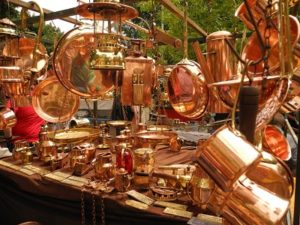There are a number of ways to decorate metal. You can paint it, stick adornments on it, or even carve through its surface. After all, metals are malleable and very easy to work. They make a great material for a variety of crafts. Copper, in particular, is one of the most extensively used metals for making art pieces, thanks to its extreme workability. And one of the best ways to decorate copper is through etching. Here’s a guide for those who want to try etching copper sheets for crafts.
Step 1: Preparation and Safety
Etching involves the use of acid or mordant, usually ferric chloride. Either chemical can burn your skin. It’s important to observe basic safety precaution to avoid possible injury. Wear safety glasses and gloves to protect your body from spillage. Before you wear them, make sure to prepare the copper sheet you will be etching first. Clean and dry it thoroughly to remove any residue that might inhibit the etching process.
Step 2: Design and Resist
Now that you have the blank copper sheet set, the next step is to choose a design and put it in a resist either through cutting or printing. A resist is a substance that covers the areas on the metal that you don’t want to be etched. It can be anything from photocopy ink to photo film. Make sure to line the resist up properly to produce a fine output. If you are using ink as your resist, make sure it is completely dry before applying the acid to prevent it from smudging. Cover the back of the plate with resist, too, so it won’t react with the solution.
Step 3: Tape and Etch
To further protect the areas on the blank surrounding the design, you have to cover them with tape. Cover even the back until there’s no air gap left. A burnisher can help push the tape flat down so all gaps are eliminated. Once you’re done, slowly lower the blank into the etching solution and leave it there for at least half an hour. Every 5 to 10 minutes, stir the solution with the blank to shake off residue and improve the etching process.
Step 4: Neutralization
Once you confirm that all sections of the design have been properly etched, prepare another solution. This time, it’s a solution meant to neutralize the acid on the plate so you can safely hold it and apply the finishing. The neutralizing solution is simply a mixture of baking soda and water. Baking soda is known to have the ability to defuse the coarseness of acids.
Step 5: Cleaning and Finishing
Once you’ve removed the tape and the resist from the blank, you’ll notice slight discoloration on the surface of the blank. Don’t panic. This is normal. All you have to do is to clean and polish the surface of the etched copper thoroughly to get rid of most of the stain and bring out the sheen hiding beneath it.
To get the best results, make sure your copper blank is made by a trusted foundry and is supplied by a reputable supplier like Rotax Metals. You don’t have to go far just to find out where to buy copper sheets because Rotax Metals is a prominent brand. Experts like them can teach you the right etching techniques as well.


